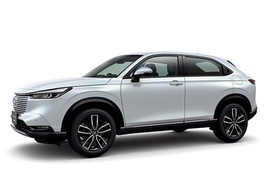
HONDA HR-V 5 Doors
Generations Timeline, Specs and Pictures

After eight years on the market, Honda retired the second generation of the HR-V and introduced its brand new successor in 2021.
Honda introduced the first generation of the HR-V in 1998, and it wasn’t such a big success since the MPV fever still had its customers. That’s why the Japanese carmaker pulled the plug on it in 2006 and waited for another seven years to bring a new generation. This time, the car was right, but the time was wrong; hence the world economic crisis hit the automotive world in late 2007. But Honda was committed to keeping the car on the assembly line.
In 2021, Honda introduced its successor and shocked its fan-base world. The third HR-V looked like it drew its lines from Hyundai Tucson. At the front, the new design language for the grille featured body-colored horizontal slats where a blue Honda badge took center stage. With its curved lines and only a few sharp angles, the new generation was completely different than any other Honda on the market, and the only part that resembled the older HR-V was the rear doors’ handles masked in the blackened frames.
Inside, Honda designers took their inspiration from the Japanese minimalism trend. The dashboard featured long lines and clean surfaces. Buttons cleared even the center stack, and the only three rotary knobs kept were for the climate control unit. On top of the dashboard, Honda installed the touch screen for the infotainment unit, suitable for screen-mirroring and supported Android Auto and Apple CarPlay connectivity.
Under the hood, Honda offered limited information at the car’s launch but assured that it would use hybrid, 4x4 systems. These were already tested on the HR-V’s second generation, but only on the Japanese market.

In 2018, Honda introduced a facelift for the HR-V crossover.
But it was more than just new headlights and bumpers. It introduced the AWD as well.
The first generation of the HR-V was unveiled in 1999, and its initials came from Hybrid Recreational Vehicle. It was not about a hybrid power, but it was a hybrid between a car and an SUV. At that time, the crossover name didn’t exist on the market. While the first generation was 3- and 5-door vehicles with AWD system, the second generation featured only 5-doors and front-wheel-drive. In 2018, that was changed.
While it kept the same shape as before, the 2019 Honda HR-V offered a new front fascia with the wing-design on the grille, which was extended to the headlights. The bumpers and the taillights were modified as well. For the Sport trim level, Honda installed new, 18”, light-alloy wheels.
The interior was changed with the introduction of a new instrument cluster for the driver. It featured a centrally mounted speedometer, a digital tachometer on the left, and a 4.2” TFT display on the cluster’s right side. The infotainment unit was changed, and it was Apple CarPlay and Android Auto compatible, which worked together with the on-board computer.
The most significant improvement was on the drivetrain. Honda installed a 1.8-liter engine under the hood. It mated it to a CVT transmission and could send the torque to the all four or only to the front wheels.

The second generation of the small cross-over Honda HR-V was launched after 8 years of absence on the market.
But the second generation was a true success.
The first generation of the Honda HR-V was based, mainly on the Civic platform and was available in 3 or 5 doors, with FWD or AWD system. But the real deal came in 2014 when the second generation was launched. Its SUV look, with narrow front end and curved body style, was a big success on the market.
Inside, there was room for five passengers with a big enough trunk to take it out for camping. Its low driving position and agile platform made it a very good all-round vehicle.
Since the platform was a carry-over from the small MPV Honda Fit/Jazz, it had a roomy interior, with a small central tunnel. The dashboard was clean an simple and featured a big infotainment touch-screen on top of the dashboard. It had its
own Honda app installed and it could be connected to a smartphone with Android Auto and Apple CarPlay. The instrument cluster was simple with big round dials. The driving position was low, more like a car and less like an SUV. The short gear-lever was a pleasure for many and a reason why the automatic transmission was not a big success for it in Europe.
Under the hood, there were two engine options, gasoline, and a diesel unit. But, since the HR-V was a light vehicle and Honda a very good engine builder, the diesel wasn’t a very popular choice.

Honda described the HR-V as a High Recreational Vehicle.
It was a crossover that saw the market in 1998, and in 2001 it received a 5-door version.
The crossover market was not invented yet in 1998 when Honda introduced the HR-V. But the Japanese carmaker took a small vehicle platform, extended its wheelbase, placed a different body on top of it, and the new HR-V. Its success was instant due to its low running costs, high seating position, and the 4x4 option. But the new model lacked a practicality factor: the rear doors. So, Honda fixed that later on. In 2001, the carmaker introduced a facelift for the entire range, and it lost the 3-door version.
Honda designers imagined an interesting shape for the headlights, with a twin semi-circular shape at the bottom, that cut their way through the top of the bumper. There was a small opening between them to coo the engine, but the bigger grille was on, the lower part of the bumper. For the greenhouse, Honda tried a mix between a station wagon and a hatchback. With the raked windshield and the flat, vertical tailgate, the result was good and formed a spacious interior. At the back, the vertically mounted taillights resembled those installed on Honda CR-V.
Inside, the car’s vertical sides and the thin doors left enough room for five adult passengers, but most versions were offered as a four-seater, and there were only two seat-belts in the back. The folding and tilting rear bench allowed an increase for the trunk area.
Under the hood, Honda offered the HR-V with a choice of two engines. Both of them were of 1.6-liter displacement but provided different output power. The Japanese crossover featured either a front-wheel-drive or an all-wheel-drive system.

After successfully introducing the Honda CR-V on the SUV-segment, the Japanese carmaker introduced a crossover based on the Civic’s platform: the HR-V.
The crossover market was almost non-existent. Even the term itself was barely used, and there were just a few offers on the table. Honda took a gamble, and it won with the light recreational vehicle that had an SUV stance, a compact-segment engine and was fitted with an all-wheel-drive system as an option.
The car’s designers didn’t take anything from the Honda range. It was a vehicle designed from scratch, and the only limitations were the technical platform. With oddly shaped headlights that took some space into the front bumper and an inch tall grille, the HR-V was a mixed breed between a compact station wagon and an SUV. The roofline was ended with a small wing in the back and a flat tailgate. Only the taillights resembled, somehow, those installed on the CR-V. The five-door version was introduced later than the three-door, in an attempt to get more attention for those who needed straight access to the rear seats.
Inside, a High Recreational Vehicle (HR-V) idea was to offer enough space for five adults and a trunk big enough for a weekend in a mountain lodge. Thanks to its big window area and oversized, door-mirrors, the car offered a 4x4 vehicle feeling. It offered standard features such as air-conditioning, power windows, power steering, and a decent audio system.
Under the hood, Honda installed a 1.6-liter naturally aspirated engine with only 106 hp. It was mated to a 5-speed manual fitted as standard or a CVT as an option. Honda sold the car with either a front- or all-wheel-drive.























































